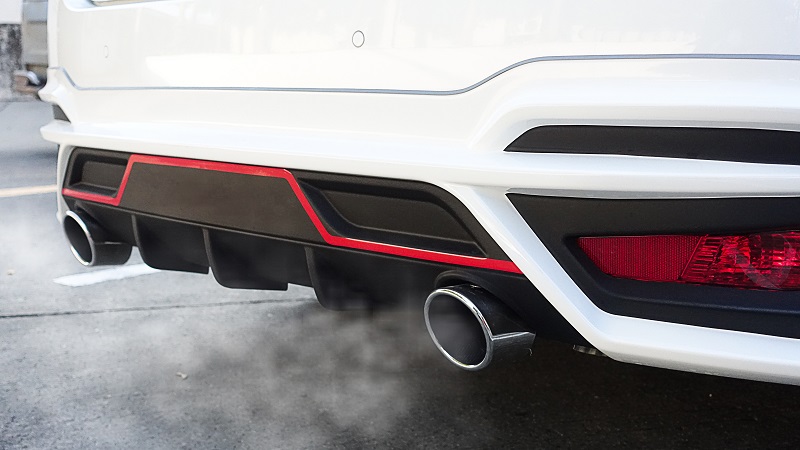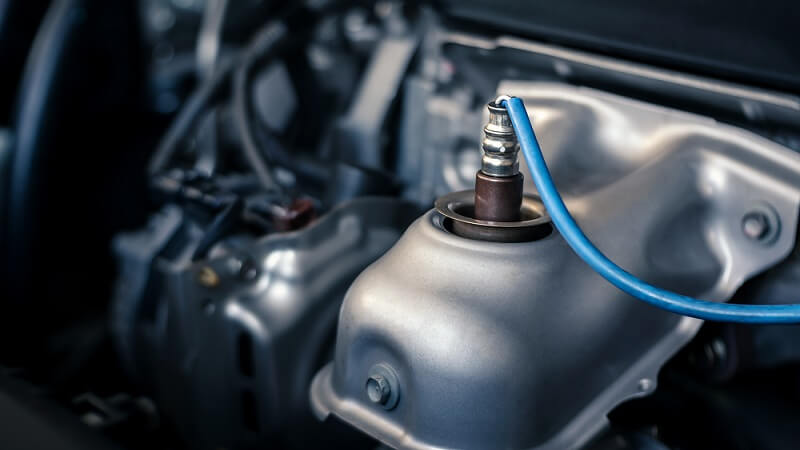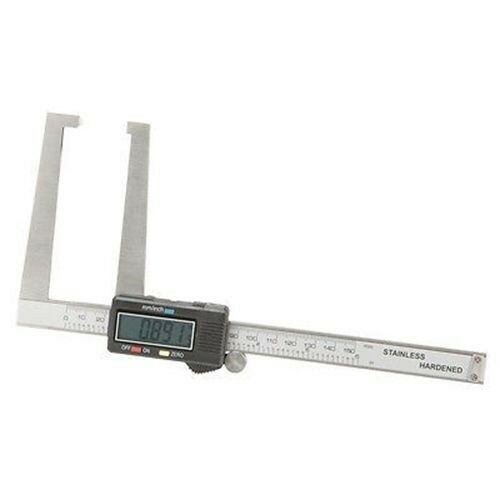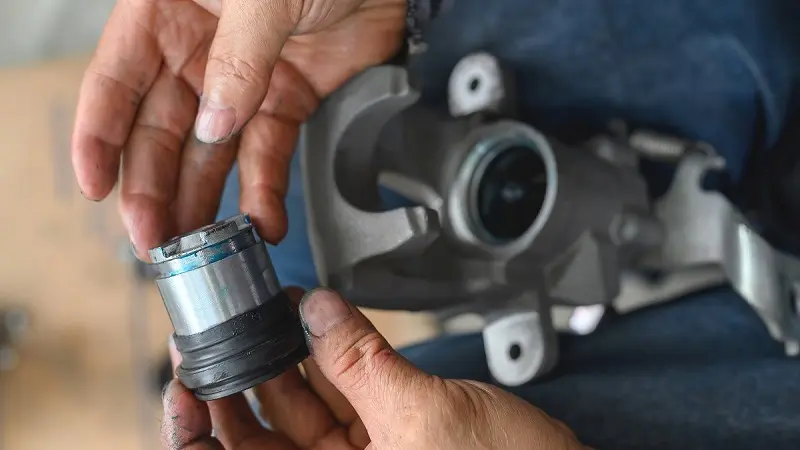Exhaust smoke is something a lot of car owners don’t pay attention to. It’s hard to blame them because it’s usually out of sight and for some — out of mind. Most drivers are only likely to notice blue smoke from exhaust only when the issue becomes severe enough. That being said, blue smoke coming from your tailpipe shouldn’t be ignored.
Here’s everything you should know about the different colors of exhaust smoke and what makes blue smoke one of the most menacing ones. We also briefly discuss what causes it and how you can go about fixing it.

Article updated on 23/12/21. Original publishing date 10/03/21.
What Color Should Exhaust Smoke Be?
A healthy engine should never emit any visible smoke from the exhaust system. Period. However, if something is wrong with the vehicle you’ll notice blue, black, or even white smoke. The colored smoke could either come out of your exhaust when the car is idling, accelerating or at all times.
While the smoke is almost always an indication of a mechanical issue, there’s a small chance that white smoke could be as harmless as condensation. On the contrary, white smoke could also be a byproduct of more serious issues like a head gasket failure. That being said, if you’re only getting white smoke on cold starts until the engine warms up, that’s most likely normal condensation. If the smoke persists, you should look into it.
Is Blue Smoke from Exhaust Bad?
While smoke from the exhaust isn’t always bad, blue smoke most definitely is. How bad exactly? Blue smoke indicates your car engine is burning oil. And at the very least, there’s likely a problem with the PCV (Positive Crankcase Ventilation) valve.
However, if you are unlucky, it could even be something much more serious like the worn piston rings. And those are right at the core of the engine making it a rather time-consuming and expensive problem to fix. The gases released from burning oil are also extremely harmful to your health and the environment.
Can Overfilling Oil Cause Blue Smoke?
Yes, there’s a possibility of blue smoke being caused by the overfilled engine oil. This can occur when the crankcase is over-pressurized due to the sump being overfilled.
Get quality engine oil for your car!
Consequently, the additional oil will be forced up the cylinder wall and into the combustion chamber. As a result, the engine starts burning oil which causes blue smoke from the exhaust. Excess oil can also lead to much bigger problems, and it should be attended to as soon as possible.
While we are on the subject of filling engine oil, it’s important to use the recommended grade as an improper one could bypass the rings on the piston or valve seals and also cause it to end up in the combustion chamber.
Blue Smoke from Exhaust – Causes, and Fixes
Overfilling engine oil or using the wrong grade aren’t the only causes of blue smoke from your exhaust. There are other reasons as well, and most of them require serious attention.
Stuck PCV Valve

When it comes to blue smoke, it goes without saying that the PCV valve is the first you should check. The purpose of this valve is to act as a crankcase ventilation system and allow internal crankcase pressures to dissipate.
Get a new, premium quality PCV valve for your car!
To put it simply, a PCV valve uses the engine vacuum to pull blow-by (combustion gases entering the crankcase) gases out of the crankcase. If the PCV valve failed, it would essentially keep mixing the engine oil with air and gases inside the engine. And the vehicle would emit blue smoke from the exhaust upon combustion of this mixture. A bad PCV valve could cause major engine trouble if ignored.
The best way to check if your PCV valve is operational is by inspecting the hoses and removing the valve and shaking it to look for a rattling sound. If it doesn’t rattle, it’s essentially stuck and needs to be replaced. Replacing a PCV valve will be the least time-consuming and lighter on the pocket than most other causes of blue smoke.
Bad Valve Stem Seals
Every internal combustion engine uses valves. These valves allow air and fuel to enter the combustion chamber while also letting out exhaust gases. Controlling these valves are rocker arms that are part of the head of the engine.
The head requires constant lubrication due to the number of moving parts. Valve stem seals, as their name suggests, are seals that sit around the valves to make sure the oil used to lubricate the head doesn’t enter the combustion chamber. What this means is that when the valve stem seals go bad, the engine begins burning oil and emits blue smoke.
Replacement valve stem seals aren’t very expensive, but changing them requires time and effort. In most cases, getting to these seals will require disassembly of the head and the removal of the spring from the rocker arm. That’s not all, the engine will also have to be re-timed as the cams and timing belt will also be taken out.
Engine Damage

As we said before, if you are unlucky, blue smoke from the exhaust could also mean that your engine is worn.
This can occur when the piston rings fail. What one has to realize is that piston rings have an incredibly important job of sealing the gap between the piston and the cylinder wall. A gap larger than necessary would affect the seal, resulting in excessive blow-by. If this is the reason for the blue smoke from your exhaust, you will notice a reduction in performance.
And if that’s the case, you should get a compression test done. Unusually low figures on any of the cylinders will indicate that your engine has suffered potentially serious damage. There is no quick and easy fix for this as your engine will need to be rebuilt.
Blown Turbo
Turbochargers are more common than they’ve ever been, which is all the more reason to keep a check on it. The workings of a turbo are quite simple, it acts as a pump and forces more into the engine. Giving it the drive it needs are the exhaust gases.
Get a new turbocharger for your car!
Thanks to the additional air, the engine can make more power. A turbocharger requires oil for lubrication, which it keeps in place with the oil seals. When these seals fail, the oil being fed to the turbo can make its way into the engine via the intake. The burning of this oil leads to blue smoke from the exhaust. Fixing a turbo requires it to be rebuilt or replaced.
Transmission Fluid Loss
Older vehicles with vacuum-controlled automatic transmissions use a modulator to manage the shifts. If this modulator malfunctions, it causes the engine to draw in the transmission fluid. This lubricating fluid is burnt just like engine oil, causing blue smoke from the exhaust.
Get quality transmission fluid for your car!
Fixing this, in most cases, will require the transmission modulator to be located and replaced. It’s also wise to change the vacuum line that it uses even if it’s not damaged as a preventative measure.
Can You Drive with Blue Smoke Coming from the Exhaust?
Blue smoke from the exhaust could be caused because of the multiple reasons stated above. In the worst-case scenario, your engine requires a rebuild.
What that also means is that your engine is already worn, which is why you won’t have a lot left to damage. However, if your car’s performance hasn’t been affected, and it has only just started emitting blue smoke, it’s recommended that you get the cause of the blue diagnosed and fixed immediately.
As long as the car isn’t burning too much oil, you could get away by driving it for a short period while you find yourself the replacement parts you’ll need.
Diagnose, and Get Ordering!
Speaking of replacement parts, you can go ahead and order whatever it is you need to deal with the problem right here! We at Newparts.com offer a wide range of OEM parts for almost all European, domestic and Asian vehicles.
The best way to go about doing this is to check the Shop section on our website. Choose the right make and model of your car, and filter through the various categories. This way, you’re guaranteed to find the best quality parts that are guaranteed to fit your vehicle!




